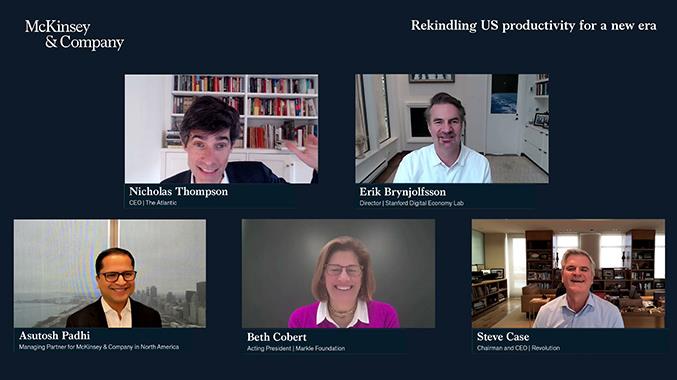Regaining historical rates of productivity growth would add $10 trillion to US GDP—or $15,000 per household. This is one of the findings in a recent McKinsey Global Institute report, Rekindling US productivity for a new era.
But before the United States realizes those gains, executives, policy makers, and other leaders must grapple with some of the challenges that could thwart growth, including workforce shortages, debt, inflation, and the cost of the energy transition.
In a virtual roundtable discussion, Markle Foundation acting president Beth Cobert, who leads the Rework America Alliance, a public–private partnership promoting career opportunities and advancement, spoke with Erik Brynjolfsson, a professor at the Institute for Human-Centered AI and director of the Digital Economy Lab at Stanford University, and Steve Case, cofounder of America Online and chairman and CEO of Revolution, a venture firm. McKinsey senior partner and managing partner for McKinsey in North America Asutosh Padhi participated as well. Nicholas Thompson, CEO of The Atlantic, moderated the discussion.
The panelists weighed in on what they believe it will take to help the United States become more productive, how to make employment more inclusive, and how to address the effects of generative AI on the workforce.
The following transcript has been edited for clarity and length.
Nicholas Thompson: Erik, let’s start with you. We’re always talking about the fact that technological advancement doesn’t lead to increases in productivity. There are two interesting stories though. Since 2005, national productivity has gone down; second, in all the places that have lots of technology companies, productivity has gone up, and in all the sectors that have lots of technology, productivity has gone up. So how can we have both of those things happening at the same time?
Erik Brynjolfsson: It’s a great question. We call it the modern productivity paradox. In the past decade, things were not so good, with about half the productivity growth rate of the ’90s and early 2000s. That’s a puzzle, and there are a couple of things going on. One is just measurement. A lot of the benefits of technology are free to users. If the cost is zero, it doesn’t show up in the GDP statistics, which means it doesn’t show up in productivity. People are spending half their waking hours consuming things that aren’t being measured. But that’s not the whole story. The bigger part is that while technology by itself leads to some productivity gains, to really get a lot of productivity, you need to rescale the workforce, and you need to transform your businesses. That transformation process can, unfortunately, take decades. I’m optimistic that it’s going to happen a lot faster in the coming year.
A few states are pulling ahead in labor productivity while the majority are falling behind
Nicholas Thompson: Steve, which side of the debate are you going to take? Do you think we’re going to lead into a huge productivity boom?
Steve Case: I’m bullish on what’s happening around innovation, particularly in some of the less studied sectors now starting to get more attention. Innovation is also producing a more inclusive economy, in more places.
On the first point, it’s interesting that in some of the most important aspects of our lives, big sectors, like healthcare, food, and agriculture, which tend to be very labor-intensive, have not really been reimagined in the way sectors in other parts of our lives, such as media or communications, have. You’re starting to see significant investment in those sectors with agtech or healthtech. It will take some time because these are complicated systems-level changes.
The data on productivity in cities is sobering, because there are a lot of states that really are getting left out or left behind [Exhibit 1]. But in the work we’ve done at Revolution with our Rise of the Rest Road Trip tours—where we visited and invested in start-ups across the country, outside of the biggest venture capital hubs—some of those cities that are currently on the bottom of the productivity list are actually showing remarkable momentum in terms of start-ups, tech, and venture capital.

Columbus, Tampa, Indianapolis, Nashville, Phoenix, and Salt Lake City are some of the cities to watch in the next decade, even though right now they’re sitting pretty low on productivity. I’ll note that the data we collected was prepandemic, but a lot of things have happened during the pandemic in terms of the dispersion of talent and capital.
Last year, Congress did pass about $3 trillion of investment in decarbonization and reshoring and infrastructure, and that’s going to have a profound impact on a lot of sectors. So I’m optimistic about this next chapter, recognizing the many challenges that we face but also seeing a lot of opportunities.
Nicholas Thompson: Beth, both Steve and Erik have mentioned inclusive growth and the concept that it will benefit more people in more ways as technological productivity increases. Do you see that happening, working closely to make sure that the benefits of the productivity we do have in technological growth is spread to all kinds of people?
Beth Cobert: I see the potential for the benefits to be spread in a much broader way, but it’s going to take deliberate action across the system to make that happen. It’s going to take investment in employees to help them build the new skills they need on top of the terrific skills that they’ve built through their previous work and life experience.
Our work at the Markle Foundation is focused on helping emphasize skills, which opens opportunities for workers, particularly those who have less formal education. We’ve got to think really carefully about the barriers that have prevented individuals from getting those jobs in the past. Steve talked about the federal investments from the infrastructure bills and the Inflation Reduction Act. There are lots of opportunities to turn that momentum into good jobs for Americans who may not have a bachelor’s degree.
Investing in employees and intangibles can boost productivity gains
Nicholas Thompson: Asutosh, you’ve looked at lots of different companies in different industries. You’ve seen which companies have become more productive and which haven’t. What are the key lessons in those industries where you’ve seen technological change lead to more productivity?
Asutosh Padhi: It starts with people. Hiring is actually one of the biggest unlocks that we have in front of us. One of the other things that I would highlight is how companies capture value from technology and digitization [Exhibit 2]. You start to see benefits from a productivity standpoint only if you support that with changes to how people operate. Companies need to look at how their metrics and incentives work. The other big aspect that we found is investment in intangibles. How much of our capital allocation is geared toward tangibles versus intangibles? By intangibles, we mean R&D, intellectual property, and the workforce. These are capabilities that compound and get better and better over time.

Erik Brynjolfsson: COVID-19 has triggered a rethinking of the workforce for the first time since World War II. Before the pandemic, about one in six Americans were working from home. At the pandemic’s peak, almost half of all Americans were working from home. That creates the opportunity for a lot of people to work further away from big cities. There are all these smart people all over the country that can now participate in creating some of this value. That’s number one.
The second thing that’s interesting is what’s happening with the very latest wave of AI. With generative AI, there’s a lot of emergent behavior that is goofy and dangerous, but some of it offers a big productivity boost in areas like coding and writing content.
Generative AI: The ‘biggest thing since fire?’
Nicholas Thompson: We have this incredible new technology. I mean, GPT-4 is bonkers. On a spectrum of “this is a cool new thing” to “this is the biggest thing since fire was discovered,” where do you put it?
Erik Brynjolfsson: It is pretty far toward the “fire” end of the spectrum. As you’ve probably seen, it can outperform 90 percent of people taking the bar exam or other kinds of exams.
Steve Case: I think generative AI is definitely more important than blockchain, but probably not as important as the internet or fire. Some of the breakthroughs have been phenomenal though. There’s almost this gold rush mentality around it. One of the things to keep an eye on is whether this creates a paradigm shift in technology. Will big-tech players be the winners here? That’s one of the things to watch, both in terms of the marketplace and some of the decisions that will be made on the policy front.
Beth Cobert: The National Skills Coalition reports that one in three workers doesn’t have basic foundational digital-literacy skills, which would prevent them from actually using this tool to advance themselves and to contribute more to their company. That points to problems around access due to wealth and education inequality, and in these cases, individuals who already have low wages and communities of color are disproportionately affected. We could miss opportunities for all of that talent to contribute in a way that really improves productivity and creates more benefits for society at large.
Asutosh Padhi: I’d make two points about generative AI. First, human judgment is still critical. Second, fact-checking is still very important. If you’re a retailer and you’re looking to personalize communications to your customers, there could be a good use case for generative AI. With the appropriate amount of information, judgment, and oversight, you could actually customize and perhaps reach more customers at a lower cost in ways that just feel more personal.
Over time, we’ll start to see what the real use cases and applications are. Until we see that, it’s a really important technology, but we will not begin to see the transformative business benefits of it.
Erik Brynjolfsson: The good news is, while this rapid transformation is going on, we also have much more powerful tools than ever before to help us understand which skills are needed and how to get people into the right jobs. If we start leveraging those tools, we can make generative AI less disruptive.
Asutosh Padhi: It’s true that we can learn ChatGPT and other generative technologies. But more than that, I think what they provide is something that’s complementary; this is technology that can enhance or build upon people’s skill sets. Employers must rethink how they are leveraging technology and provide the right training and tools. There’s a reimagination opportunity there that could be a huge boon for productivity.
Nicholas Thompson: What is the impact of ChatGPT on education and learning? Will that disrupt those industries for the worse?
Beth Cobert: ChatGPT will definitely change the dynamics of education. To me, the question is: What are we trying to do when we’re teaching? Are we helping people learn how to be critical thinkers? How can we use generative AI in that process? You need to be able to assess the information that comes from it. The only thing you can do in education is to not ignore the technology, and to determine how it supplements what you’re teaching.
Steve Case: We also have to make sure we’re reimagining education so we’re teaching people the skills that ChatGPT, AI technology, and robots in general can’t replicate.
Lifelong training enhances productivity
Nicholas Thompson: We have a couple of great audience questions. The first one is for you, Beth. How will productivity be affected by the upcoming retirement of baby boomers? Will this further decrease productivity? When it comes to retraining the workforce, how do you think about demographics, with the country getting older?
Beth Cobert: We must recognize a couple of things. It is critical to understand that people can reinvent themselves over the course of their lifetime.
If we think about skilling, it’s not just what happens from age 18 to 22, and if it doesn’t happen then you’ve missed the window. We have to recognize that it needs to happen over the course of what is going to be a very long career. If we don’t, we’re going to miss the ability to tap into the wisdom and the expertise and the skills of all individuals. What we have to do is use the right technology tools to actually change business processes in a way that improves productivity.
Will companies support those individuals to help them get that kind of targeted training that will enable them to adapt? Not only will the company benefit from the individual’s experience, but the individual will also enjoy the benefits that training has on their income and mobility.
What we have to do is use the right technology tools to actually change business processes in a way that improves productivity.
Hybrid work requires more thoughtfulness on employee collaboration and learning
Nicholas Thompson: How does the new remote and hybrid work environment affect productivity?
Erik Brynjolfsson: It depends a lot on the type of occupations. There are some jobs that are much more remote than others. If you’re working on an assembly line or if you’re working in personal services, it’s unlikely you can do any of your work remotely. Some jobs you can do partly remote. A very common model, as I mentioned briefly, is this hybrid model where people are spending more time remote, but they still come in maybe a couple of days a week for some of that face-to-face work. There’s magic that happens when people are side by side.
Nicholas Thompson: Who has an easier time reskilling and learning new jobs, people who work remotely or people who work in the office?
Erik Brynjolfsson: Well, let me say a little bit about job creation. There seems to be a lot more job changing among remote workers. There are some people who have [taken on additional] jobs, their employer doesn’t know it, and they’re working multiple jobs remotely.1 So that’s something that is a lot easier to pull off when you’re remote.
Asutosh Padhi: Just to build on that, it depends on the type of skill you’re looking at, but there are certain careers that lend themselves to an apprenticeship-based model. In those cases, I think it’s much easier to learn when you’re in person. It’s not impossible to learn in a remote setting, but it means that you need to be intentional. It requires a lot more thoughtfulness around what the collaboration model really looks like.


